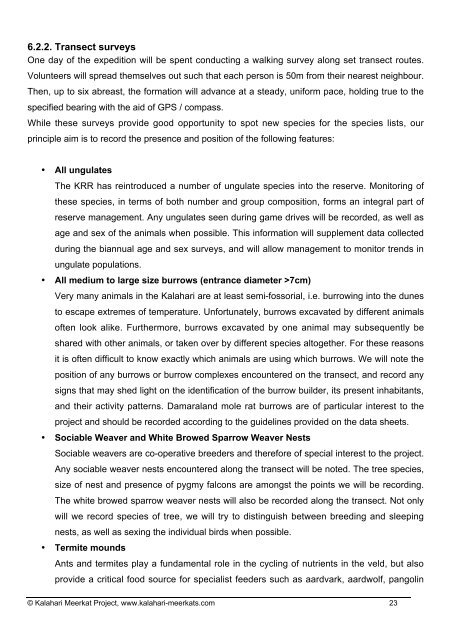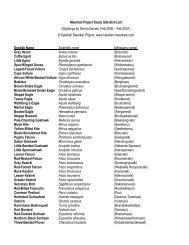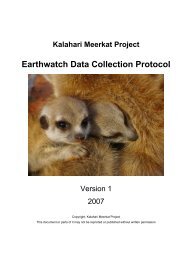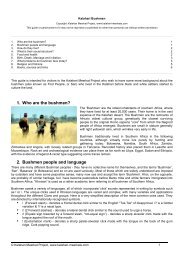Earthwatch Field Guide - The Kalahari Meerkat Project
Earthwatch Field Guide - The Kalahari Meerkat Project
Earthwatch Field Guide - The Kalahari Meerkat Project
You also want an ePaper? Increase the reach of your titles
YUMPU automatically turns print PDFs into web optimized ePapers that Google loves.
6.2.2. Transect surveysOne day of the expedition will be spent conducting a walking survey along set transect routes.Volunteers will spread themselves out such that each person is 50m from their nearest neighbour.<strong>The</strong>n, up to six abreast, the formation will advance at a steady, uniform pace, holding true to thespecified bearing with the aid of GPS / compass.While these surveys provide good opportunity to spot new species for the species lists, ourprinciple aim is to record the presence and position of the following features:• All ungulates<strong>The</strong> KRR has reintroduced a number of ungulate species into the reserve. Monitoring ofthese species, in terms of both number and group composition, forms an integral part ofreserve management. Any ungulates seen during game drives will be recorded, as well asage and sex of the animals when possible. This information will supplement data collectedduring the biannual age and sex surveys, and will allow management to monitor trends inungulate populations.• All medium to large size burrows (entrance diameter >7cm)Very many animals in the <strong>Kalahari</strong> are at least semi-fossorial, i.e. burrowing into the dunesto escape extremes of temperature. Unfortunately, burrows excavated by different animalsoften look alike. Furthermore, burrows excavated by one animal may subsequently beshared with other animals, or taken over by different species altogether. For these reasonsit is often difficult to know exactly which animals are using which burrows. We will note theposition of any burrows or burrow complexes encountered on the transect, and record anysigns that may shed light on the identification of the burrow builder, its present inhabitants,and their activity patterns. Damaraland mole rat burrows are of particular interest to theproject and should be recorded according to the guidelines provided on the data sheets.• Sociable Weaver and White Browed Sparrow Weaver NestsSociable weavers are co-operative breeders and therefore of special interest to the project.Any sociable weaver nests encountered along the transect will be noted. <strong>The</strong> tree species,size of nest and presence of pygmy falcons are amongst the points we will be recording.<strong>The</strong> white browed sparrow weaver nests will also be recorded along the transect. Not onlywill we record species of tree, we will try to distinguish between breeding and sleepingnests, as well as sexing the individual birds when possible.• Termite moundsAnts and termites play a fundamental role in the cycling of nutrients in the veld, but alsoprovide a critical food source for specialist feeders such as aardvark, aardwolf, pangolin© <strong>Kalahari</strong> <strong>Meerkat</strong> <strong>Project</strong>, www.kalahari-meerkats.com 23





